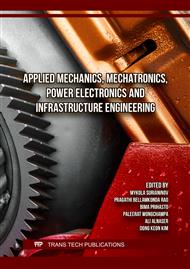p.59
p.73
p.91
p.101
p.109
p.117
p.127
p.139
p.153
Solar-PV Integrated Electric Vehicle Charging System with Bilateral Chopper
Abstract:
This paper introduces a cutting-edge solar photovoltaic (PV) tied electric vehicle (EV) charging system integrating a bilateral chopper. The system aims to optimize energy utilization and enhance grid interaction by allowing bidirectional power flow between the solar PV array, electric vehicle, and the grid. The bilateral chopper serves as a pivotal component, enabling seamless energy transfer, storage, and distribution. The proposed system incorporates advanced control algorithms to manage energy flow dynamically, considering variables such as solar irradiance, EV charging demands, and grid conditions. The bidirectional converter facilitates efficient energy exchange, allowing surplus solar energy to charge the EV and, conversely, enabling the EV to provide power back to the grid during peak demand or grid support scenarios. Key features of the system include real-time monitoring and control through a smart grid interface, enabling users to optimize charging schedules based on renewable energy convenience and grid conditions. The bilateral chopper enhances the system's flexibility, enabling it to operate in grid-tied, off-grid, or hybrid modes, contributing to increased sustainability and resilience in the overall energy ecosystem. This innovative solar PV tied electric vehicle charging system offers a compelling solution for promoting clean and sustainable transportation while effectively integrating non-conventional energy sources into the broader power grid. The research findings provide valuable insights into the feasibility, performance, and potential benefits of such integrated systems in the context of future smart and sustainable energy infrastructures.
Info:
Periodical:
Pages:
109-115
Citation:
Online since:
December 2024
Price:
Сopyright:
© 2024 Trans Tech Publications Ltd. All Rights Reserved
Share:
Citation:



